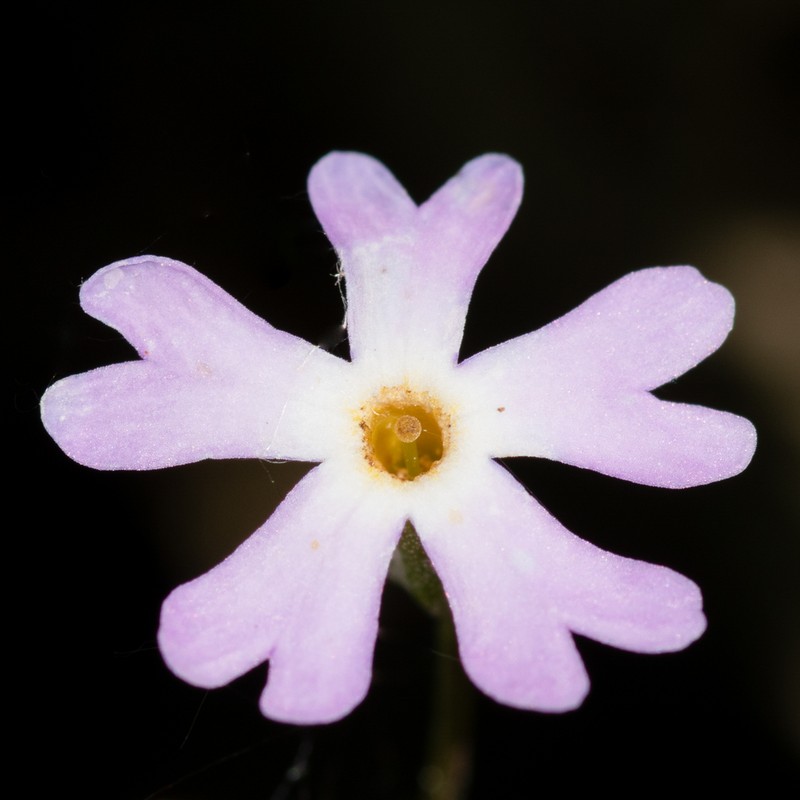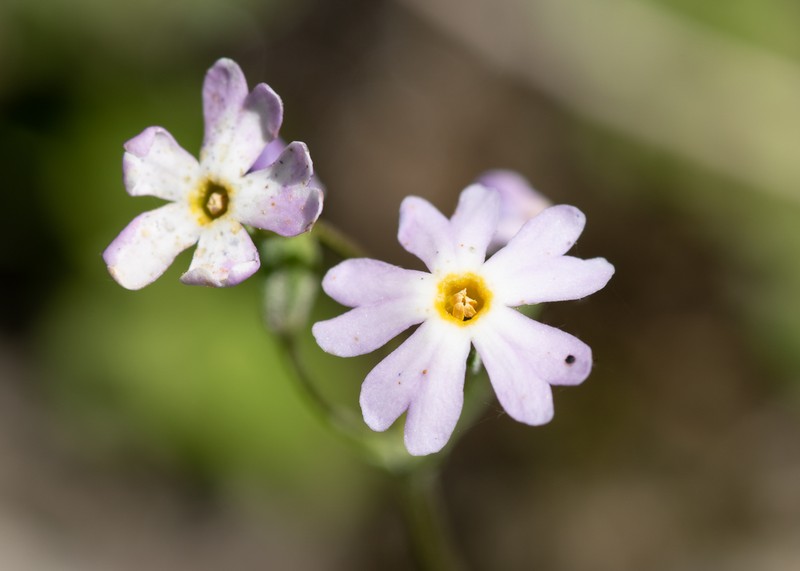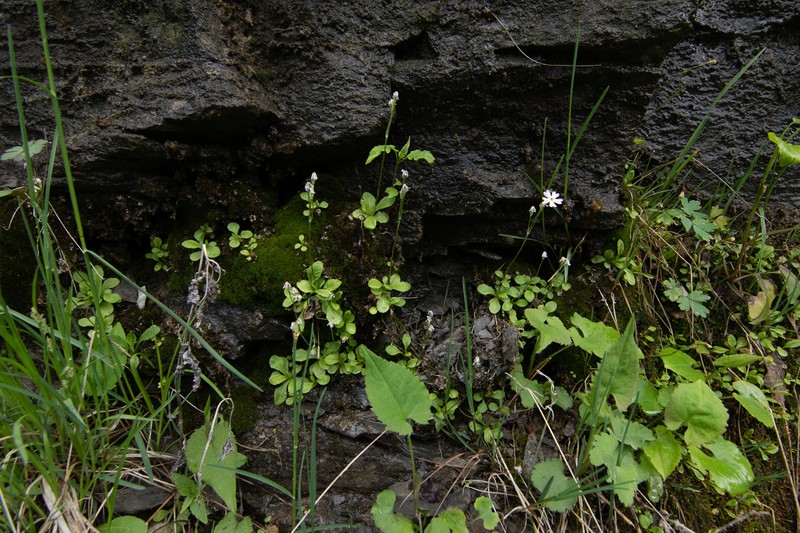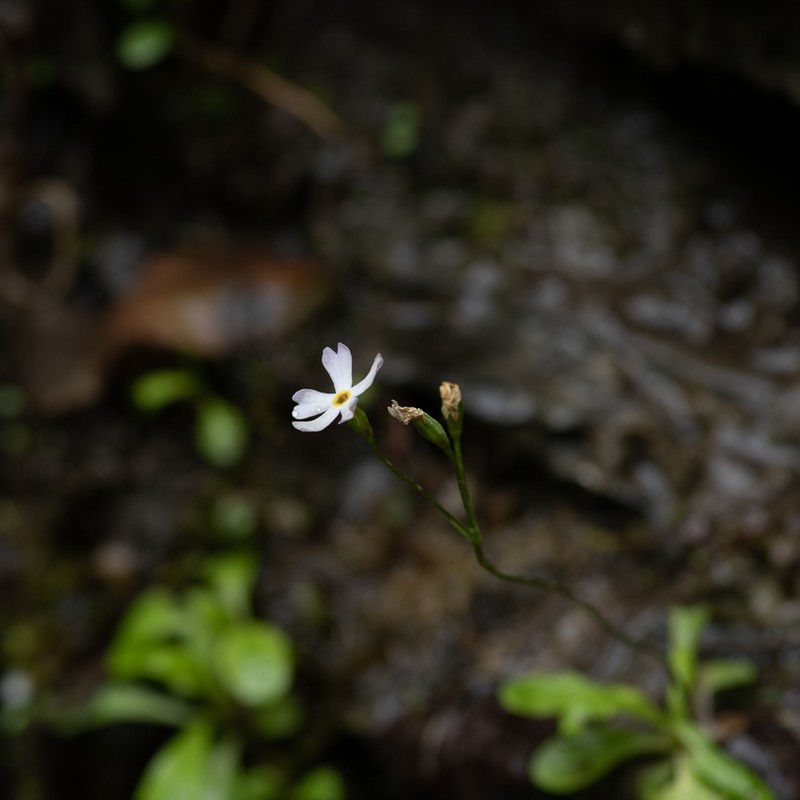Bird's Eye Primrose
Primula mistassinica Michx.
- Class
- Dicotyledoneae (Dicots)
- Family
- Primulaceae (Primrose Family)
- State Protection
- Threatened
Listed as Threatened by New York State: likely to become Endangered in the foreseeable future. For animals, taking, importation, transportation, or possession is prohibited, except under license or permit. For plants, removal or damage without the consent of the landowner is prohibited.
- Federal Protection
- Not Listed
- State Conservation Status Rank
- S2
Imperiled in New York - Very vulnerable to disappearing from New York due to rarity or other factors; typically 6 to 20 populations or locations in New York, very few individuals, very restricted range, few remaining acres (or miles of stream), and/or steep declines.
- Global Conservation Status Rank
- G5
Secure globally - Common in the world; widespread and abundant (but may be rare in some parts of its range).
Summary
Did you know?
Primula mistassinica is named for Lake Mistassini, the largest lake in the Québec province. While these plants in Canada are usually found on the ground in bogs and marshes, this plant only survives on cold seepy cliff faces in New York.
State Ranking Justification
There are twelve known populations and approximately 9 additional historical populations of this plant. Most of these populations are on well-protected cliffs, but some cliffs may be subject to natural or artificial sloughing. This plant has a limited range, and an even greater limited habitat. As a plant at the southern limit of its range, it has always likely been rare in New York.
Short-term Trends
The short-term trend of this plant seems to be stable. This plant is difficult to survey and population counts from year-to-year are usually not recorded. Changes would be noted only if the area where the plants occur was drastically altered. This has not occurred in the recent past.
Long-term Trends
Over half of the 13 historical sites for this plant have been rediscovered and no sites have been considered extirpated. The habitat for this plant is not common but it is isolated and inaccessible enough that the plants are expected to remain here for many decades.
Conservation and Management
Threats
There are few threats to these plants since the sites are inaccessible and not open to disturbance. Changes in the amount of groundwater available to the sites could affect the areas where this plant is found, thereby also impacting the plants. So far no exotic invasive plants have been seen dominating these sites.
Conservation Strategies and Management Practices
Sites should be monitored for changes in groundwater availability and for any new invasive plants that might be affecting them. There are a handful of invasive species that may cause competition problems.
Research Needs
There are no known research needs at this time.
Habitat
Habitat
A plant of seepage areas on open limy-shale cliffs or in the mist of a nearby waterfall. These sites have been lumped under the cliff community designation, but they may be best described as vertical marly fens. The sites are usually surrounded by birch, hemlock, and maple. (New York Natural Heritage Program 2005). Abundant in damp calcareous meadows and interdunal flats along the Great Lakes; inland local to marly bogs (fens), on calcareous banks and sandstone cliffs, and in other cool damp places; areas with Pinguicula vulgaris; associated species: Carex crawei, Carex garberi, Eleocharis pauciflora, Parnassia parviflora, Rhynchospora capillacea, Selaginella selaginoides (Voss 1996). Rocks, cliffs, and gravelly shores (Gleason and Cronquist 1991). Calcareous or argillaceous rocks, shores and meadows (Fernald 1970).
Associated Ecological Communities
- Calcareous cliff community*
(guide)
A community that occurs on vertical exposures of resistant, calcareous bedrock (such as limestone or dolomite) or consolidated material; these cliffs often include ledges and small areas of talus.
- Cliff community
(guide)
A community that occurs on vertical exposures of resistant, non-calcareous bedrock (such as quartzite, sandstone, or schist) or consolidated material; these cliffs often include ledges and small areas of talus.
- Shale cliff and talus community
(guide)
A community that occurs on nearly vertical exposures of shale bedrock and includes ledges and small areas of talus. Talus areas are composed of small fragments that are unstable and steeply sloping; the unstable nature of the shale results in uneven slopes and many rock crevices.
* probable association but not confirmed.
Associated Species
- Aquilegia canadensis (wild columbine, red columbine)
- Carex flava (yellow sedge)
- Conocephalum conicum
- Cystopteris bulbifera (bulblet fern)
- Eupatorium rugosum
- Impatiens capensis (spotted jewelweed, spotted touch-me-not)
- Lobelia kalmii (Kalm's lobelia)
- Parnassia glauca (common grass-of-Parnassus)
- Pinguicula vulgaris (butterwort)
- Saxifraga aizoides (yellow mountain saxifrage)
- Saxifraga virginiensis
- Solidago ohioensis (Ohio flat-topped-goldenrod)
- Tussilago farfara (colts-foot)
Range
New York State Distribution
This plant is limited to central New York, ranging from the Tug Hill Region west to the Genessee River Gorge. This plant is usually associated with the spray zone of waterfalls and within seepage areas of cliffs made up of fosilliferous shale. New York is near the southern limit of its range.
Global Distribution
This plant ranges from Labrador to Alaska, south to Maine, central New York, northern Illinois, Michigan, and Wisconsin.
Identification Comments
General Description
Bird's-eye primrose is a short plant that is visible most of the year as a small basal rosette of light green, spoon-shaped, toothed leaves. The undersides of the leaves are often white-powdery. When it flowers it produces a small cluster of small showy flowers at the end of a 6-10 inch narrow, leafless stalk. The five notched petals are pink on the outside grading towards yellow-white in the center. The fruits are five-parted capsules that persist late into the season.
Identifying Characteristics
This very slender plant may get up to 35 cm tall. The toothed leaves are sessile or short petioled. The scape is filiform and 0.3-1.4 mm thick at the summit. The involucral bracts are usually non-saccate at the base and 2-6 mm long. The calyx is slenderly campanulate, 3-6 mm long, and 2-3.5mm thick. The corolla tube is yellow. The limb is 0.8-2 cm broad, pale pink, lilac, bluish-purple or rarely white with all color forms having a conspicuous yellow eye. The top of the stigma or tips of anthers are exserted on old flowers. The capsule is subcylincric, 2-3 mm thick, and the half valves are 0.5-0.9 mm wide. The rounded seeds are nearly smooth.
Best Life Stage for Proper Identification
For positive identification either flowers or fruits should be present, but it may be identified vegetatively based on habitat and morphological characters. A photo and habitat description should be enough to verify the identification.
Similar Species
This is a rather unique species when combining habitat and morphological characters. The only other species in the same habitat that may create confusion is Lobelia kalmii.
Best Time to See
This plant flowers from mid-May through the summer, although peak flowering is late spring to early summer. Fruiting stalks may persist into the following field season, but most individual fruits disperse by the first frost. For those familiar enough with this plant to identify it vegetatively, field surveys may be conducted at any point during the growing season. Those not familiar with this plant may wish to limit surveys to the peak flowering period.
- Vegetative
- Flowering
- Fruiting
The time of year you would expect to find Bird's Eye Primrose vegetative, flowering, and fruiting in New York.
Bird's Eye Primrose Images
Taxonomy
Bird's Eye Primrose
Primula mistassinica Michx.
- Kingdom Plantae
- Phylum Anthophyta
- Class Dicotyledoneae
(Dicots)
- Order Primulales
- Family Primulaceae (Primrose Family)
- Order Primulales
- Class Dicotyledoneae
(Dicots)
- Phylum Anthophyta
Additional Common Names
- Mistassini primrose
Synonyms
- Primula intercedens Fernald
- Primula mistassinica var. intercedens (Fernald) B. Boivin
- Primula mistassinica var. noveboracensis Fernald
Additional Resources
Best Identification Reference
Gleason, Henry A. and A. Cronquist. 1991. Manual of Vascular Plants of Northeastern United States and Adjacent Canada. The New York Botanical Garden, Bronx, New York. 910 pp.
Other References
Fernald, M.L. 1950. Gray's manual of botany. 8th edition. D. Van Nostrand, New York. 1632 pp.
Holmgren, Noel. 1998. The Illustrated Companion to Gleason and Cronquist's Manual. Illustrations of the Vascular Plants of Northeastern United States and Adjacent Canada. The New York Botanical Garden, Bronx, New York.
Mitchell, Richard S. and Charles J. Sheviak. 1981. Rare Plants of New York State. Bull No. 445. New York State Museum. Univ. of New York. State Ed. Department Albany, NY.
Mitchell, Richard S. and Gordon C. Tucker. 1997. Revised Checklist of New York State Plants. Contributions to a Flora of New York State. Checklist IV. Bulletin No. 490. New York State Museum. Albany, NY. 400 pp.
New York Natural Heritage Program. 2010. Biotics database. New York Natural Heritage Program. New York State Department of Environmental Conservation. Albany, NY.
New York Natural Heritage Program. 2024. New York Natural Heritage Program Databases. Albany, NY.
Voss, Edward G. 1996. Michigan Flora Part III. Dicots Concluded (Pyrolaceae - Compositae). Cranbrook Institute of Science Bulletin 61 and University of Michigan Herbarium. 622 pp.
Weldy, T. and D. Werier. 2010. New York flora atlas. [S.M. Landry, K.N. Campbell, and L.D. Mabe (original application development), Florida Center for Community Design and Research http://www.fccdr.usf.edu/. University of South Florida http://www.usf.edu/]. New York Flora Association http://newyork.plantatlas.usf.edu/, Albany, New York
Links
About This Guide
Information for this guide was last updated on: February 1, 2023
Please cite this page as:
New York Natural Heritage Program. 2024.
Online Conservation Guide for
Primula mistassinica.
Available from: https://guides.nynhp.org/birds-eye-primrose/.
Accessed July 26, 2024.





